|
The
process that led to the opening of the world’s first regularly
scheduled high-definition television service by the BBC in
1936 was a long and complex one, employing not one but two
almost incompatible systems, brought together by uniquely
British compromise. In these two articles, Richard
Elen
tells the story of how high-definition television came to
London.
Part
1: Baird and the BBC
“Gentlemen,
you have now invented the biggest time-waster of all time.
Use it well.”
– Isaac Shoenberg, head of the Marconi-EMI TV development
team
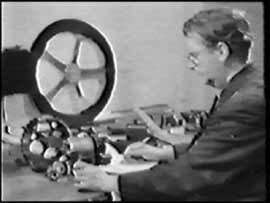
Baird
with the innards of a 30-line mechanical Televisor receiver
(from "Television Comes To London", BBC, 1936)
John Logie Baird
is rightfully regarded as the father of television, but the
experimental “low definition” transmissions on medium wave
that the BBC, after continuing lobbying of the Postmaster
General, Sir William Mitchell-Thompson, by the Baird company,
began, from September 30, 1929, to transmit on 2LO from Baird’s
studio facility at Savoy Hill were hardly representative of
the shape of things to come.
The single broadcast
wavelength was not able to carry both sound and picture,
and as a result the test transmissions had to alternate
between sound and vision until the following year, and
were carried on outside normal broadcasting hours. And
most important of all, the pictures, by modern standards,
were terrible.
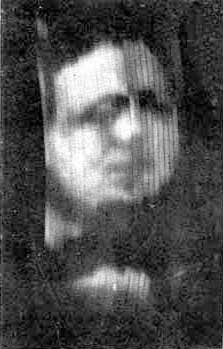
The
first photo of a television image ever published:
a screen shot from Baird's Televisor in 1926.
Baird’s television
system at the time consisted of a mass of whirring discs at
both the transmission and the reception end of the system.
The transmission mechanism was almost completely counter-intuitive.
With the “flying
spot” method used initially, a rotating disc with 30 holes
punched in it had a powerful lamp behind it. As the disc rotated,
a spot of light scanned the object in the studio while banks
of photocells registered the changes in reflected light intensity,
and these changes were amplitude modulated on to a medium
wave carrier.
The “lighting”
of the object could be changed somewhat by varying the sensitivity
of the photocells, but the basic picture was created from
no more than 30 vertical, slightly curved lines, at a rate
of 25 frames per second. Shadowy heads and shoulders were
the best that could be managed.
Viewed on a
Baird “Televisor”, of which several thousand had been sold
over the previous few years while Baird was transmitting experimentally
from his own premises, the tiny, flickering picture, effectively
4 in high by 2 in wide, was seen through a lens looking at
a modulated neon lamp through another spinning disc, rotating
in sync (you hoped) with the wheel in the studio.
Synchronisation
was a difficult trick to manage, and there were even crude
videodiscs produced which could help you get your machine
up to speed before the beginning of transmissions. If your
receiver drifted out of sync, the picture dissolved into meaningless
dots and lines. Such was the experimental “low definition”
service from the BBC.
There were some
notable firsts, however, including a performance of Pirandello’s
play, “The Man with a Flower in His Mouth” – the first
play to be performed on television in Britain, on July 14,
1930, and produced with the assistance of the BBC’s Programme
Branch.
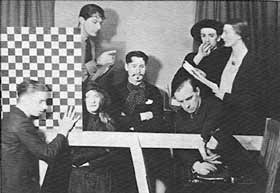
The set of Pirandello's play, "The
Man with the Flower In His Mouth",
the first play performed on British television, in 1930.
Note the chequered
"fade board" on the left - see text. (BBC)
The area that
could be illuminated by the flying spot and reproduced with
30 lines was so small that only one actor could appear on
“stage” at a time, with a special “fade board” of chequered
squares slid in front of the photocells when it was necessary
for a new actor to appear. And if any movements were too sudden,
the system was all too likely to lose sync.
The BBC Control
Board was not particularly pleased with the results. On July
22, 1930, they decided to suspend programming involvement
and continue solely with engineering support, the minimum
they were obliged to give Baird under their orders from the
PMG.
Technical
advances
The Baird Company
found a method of using the flying spot scanner to broadcast
movie film, and as a result developed the earliest “telecine”
apparatus, which worked with some success.
A new scanning
system based on a rotating drum with 30 angled mirrors was
brought into use, with some initial difficulties including
the mirrors flying off and causing considerable consternation,
if not damage, and the photocells improved to the point where
they could be mounted on movable stands and angled and positioned
carefully, to be used as the equivalent of spotlights.
The first outside
broadcast followed, and then the Derby was televised live
in June 1931 and with higher quality the following year. Noel
Ashbridge, who had replaced P.P. Eckersley as the BBC’s Chief
Engineer, advised Lord Reith to take television seriously,
and on August 22, 1932, basement studio BB in the newly completed
Broadcasting House was opened, and the BBC began a regular
television service, albeit still experimental and still low-definition.
Vision was transmitted on 261.3 metres and sound on 398.9
metres, medium wave.
In 1934 the
studio moved from Broadcasting House up the street to a specially
converted studio at 16, Portland Place.
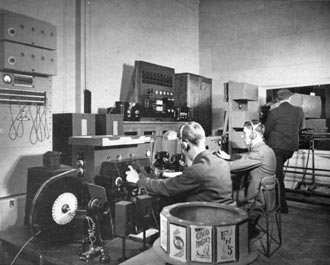
The
Baird 30-line studio at 16, Portland Place, around
1934. Note the forerunner of the "Wooden Mickey" caption
carousel in the foreground. L to R: Tony Bridgewater
(sound), John Bliss (vision) and Desmond Campbell at
the flying
spot "camera".
In addition
to the main flying spot system there was a second scanner
in the control room that was pointed at caption cards
about the size of postcards, such as the one shown below.
The two “cameras” could also be mixed, and used for primitive
matting of an actor in the main studio with scenery on
a caption card.
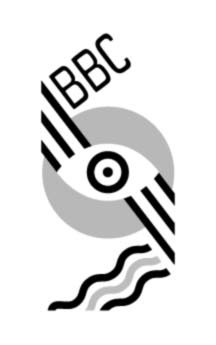
Recreation
of a BBC Caption Card from the 30-line service (R. Elen).
The card is visible on the carousel in the photo above.
Transmissions
were now broadcast from the transmitter at Brookmans Park.
Receiver technology improved, with the development of mirror-drum-based
receivers, but the 30-line video was still flickery and indistinct,
particularly after having travelled the phone lines to Brookmans
Park from central London.
The Second
System
But meanwhile,
something else was happening. Television had been hampered
by the fact that the ideas that went into it were some way
ahead of the technical capability to implement them.
The rotating
disc method had been patented by Nipkow in 1884, but it was
not until the twenties that Baird was able to get it beyond
the shadowy images stage, while in 1908 A A Campbell Swinton
had written to the journal Nature indicating how “distant
electric vision” could be transmitted and received by means
of the cathode ray tube.
Again, the realisation
of this all-electronic method of creating and decoding a television
signal required the development of valves and improvements
in the sensitivity of photoelectric materials – but these
were to come.
Vladimir Zworykin,
working for RCA in the USA, and J D McGee at EMI, evidently
developed the first cathode ray “camera” tubes independently.
EMI had already made progress with CRTs for use in television
receivers – including receiving 150-line mechanically generated
signals – and ultimately with the help of all-round genius
Alan Dower Blumlein, McGee and W F Tedham, initially secretly,
managed to transmit a picture all-electronically across the
laboratory in 1932.
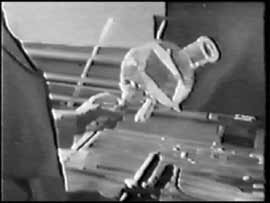
Making
an EMI "Emitron" camera tube.
The light-sensitive mosaic can be seen inside the tube
(BBC - "Television Comes To London")
Their camera
used a light-sensitive mosaic that was discharged pixel by
pixel as an electron beam scanned it, the discharge current
intensity being proportional to the light falling on the dot.
At the other
end, a CRT’s electron beam scanned a phosphorescent screen
in sync with the transmission end, and lit up phosphor dots
in the screen when they corresponded to illuminated dots in
the camera mosaic.
By the end of
November, EMI had shown the BBC a 5 inch-square CRT receiver
capable of receiving 150-line mechanically generated transmissions
via VHF over a distance of two miles. EMI wanted the BBC to
begin transmissions with their system the following year,
but to avoid political problems and because the EMI system
was at that time only capable of telecine operation, Sir John
Reith at the BBC preferred to keep the Corporation’s research
with EMI under wraps.
Luckily, the
head of the EMI television team, Isaac Shoenberg, did not
give up, and when Zworykin published information on his “iconoscope”
in 1933, the team was able to read between the lines enough
to know that their “Emitron” was virtually identical.
Knowing they
were on the right course, EMI brought additional resources
to bear, working not only on cameras but on higher vacuums
and on improving the performance of receiving-end CRTs, developing
screens larger than 7in and a true black-and-white display
rather than the black-and-green previously demonstrated.
Baird knew by
now that there was competition in the wings, and tried to
smear EMI by claiming that theirs was an American-controlled
invention, although Shoenberg had turned down an offer from
RCA, feeling that EMI were in front of the Americans technologically
and that they had little, if anything, to learn from them.
EMI showed a
120-line all-electronic system to the BBC and the GPO, who
regarded it as superior to Baird’s latest effort, which was
now also offering 120 line images, telecine and a CRT-based
electronic receiver. Baird increased the number of lines to
180 and began to use VHF for additional bandwidth, as EMI
were already doing.
Initial electronic
transmission demonstrations to EMI management in early 1934
were disappointing. Their mechanical transmission system was
now up to 180 lines and the electronic images, initially,
were vastly inferior.
But by April,
they had significantly better results. EMI built a vision
mixer with six channels – two telecine and four Emitron cameras
– and were able to run a camera outside the Hayes factory
by the local canal as well as cameras in the studio and for
telecine to show the system off to the BBC when they came
to visit, on 18 April 1934.
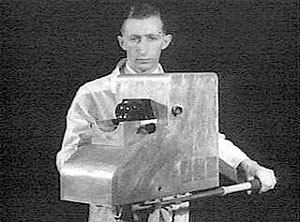
Early
Emitron cameras like this one did not have viewfinders
(BBC - "Television Comes To London")
The BBC’s Engineer
In Charge of Television, Douglas Birkinshaw, quoted in Bruce
Norman’s impressively-researched (if not always 100% accurate)
work on early British television, Here’s Looking At You,
noted: “No whizzing discs, no mirror drums: silence, lightness,
portability. It showed the way things were going. It was quite
easy to see, even then, that the Baird system couldn’t eventually
lead anywhere…”
He felt that
it was inevitable that TV would have to provide outside broadcasts,
and with the Baird system’s heavy, fixed equipment, this didn’t
seem possible.
Following his
success in the telecine field, Baird borrowed an idea from
his licensees in Germany, where they had developed a system
of using a film camera to shoot studio images, the film going
instantly into baths of developer, fixer and then water, and
while underwater was scanned by a flying spot scanner.
The British
implementation of the system – called the “Intermediate Film
Technique” – worked, some of the time, but it had problems
with underwater air-bubbles interfering with the sound, and
also with the fact that it needed lethal cyanide developer
to get the processing time down to “almost instantaneous”
– in fact it took just under a minute.
Baird, obliged
to begin to consider electronic transmission technologies,
somewhat half-heartedly struck up a relationship with American
Philo T. Farnsworth, whose system, although it had major flaws
that Baird might have been able to sort out, did produce electronic
pictures.
High-Definition
Considered
In the middle
of 1934, the government set up the Television Committee, under
the chairmanship of the Postmaster General Sir William Mitchell-Thompson,
now Lord Selsdon, including BBC, government and GPO representatives.
Its job was
to evaluate the possibility of replacing the existing low-definition
service with a high-definition successor, and which system
to use to do so.
Baird was by
now offering a gamut of technologies including 30-line flying
spot, Intermediate Film at 180 lines and telecine at 240 lines,
25 frames per second, all using mechanical scanning. There
was also the Farnsworth all-electronic option if they could
iron out its problems. EMI, now working with Marconi to provide
them with transmission capability, were officially offering
240-line mechanically scanned telecine and little else – as
their electronic system was still in its infancy.
Shoenberg decided
to take the plunge and committed the Marconi-EMI team to delivering
405 lines, 50 frames – and, giving up drum scanning, to all-electronic
signal generation. It was an incredible leap of faith.
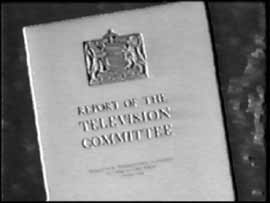
The Selsdon Report
The Selsdon
Report was issued on January 31, 1935, and Lord Selsdon
announced
that there would be two systems of television for the London
High-Definition TV service: Baird and EMI, chosen from
half
a dozen contenders. High-definition was defined as a minimum
of 240 lines, 25 frames – the limit of the Baird system.
The two systems would run side by side for six months,
alternating
programmes.
After the event,
it became evident that there had been political motives behind
this complex and expensive compromise – protecting the government
and the Post Office from criticism that would have resulted
from excluding Baird, who was, of course, the pioneer television
broadcaster.
It also seems
that they saw bankruptcy of the Baird company, already in
financial difficulties, as likely and didn’t want to that
to be blamed on their excluding Baird either.
On September
11, 1935, the BBC closed down its low-definition service,
which certainly was a blow to Baird, and orphaned the several
thousand medium wave mechanical Televisors already in the
marketplace.
High-definition
TV was coming to London – and the BBC had just eighteen months
to do it. Gerald Cock, formerly the BBC’s Outside Broadcast
Director, was appointed Director, Television Service.
To
Part II - "Magic Rays of Light"
|